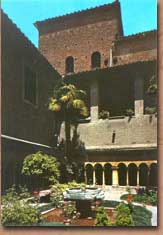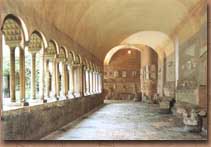Project Guidelines
by Giovanni Carbonara
The objective of the intervention proposed for the cloister of Ss. Quattro Coronati is that of not simply being a technical operation, but the logical conclusion of a critical process that evaluates the historical, iconographical, symbolical and also spiritual nature of the complex in the state that it has come down to us, and consequently recognizes it as a 'cultural asset' and part of the world's heritage.
The analysis of the material and figurative nature of the cloister has been rigorously and accurately carried out through researching and analyzing its every aspect; first of all, a critical survey of its constituent elements followed by excavations and tests to solve individual problems. This data has been collated with other data from archive and bibliographic sources.
Special attention has been paid to the co-ordination of the relationship between the various disciplines, which are necessarily involved in developing a project (philology, historical criticism, physics, chemistry, diagnosis, etc.)
The scope of the research carried out has not just been for cognitive purposes, but also to determine an approach to conservation and restoration treatment, above all concerning important issues of lacunae re-integration and removal of added elements.
In this sense it has been fundamental to recognize the significance of the present image, in its entirety and in its individual components, in order to determine what to all effects must be considered a lacuna - the result of neglect or improper restoration, or rather an authentic sign of the passage of time; whether it represents an incongruous presence or an element that by now not only historically but physically belongs to the established perception of the cloister.
From a critical evaluation of the existing factors, it has emerged that the present appearance of the cloister is largely the result of the restoration work carried out between 1913 and 1916 by Antonio Munoz, the accomplished restorer who worked on a number of important monuments in Rome. His work on the cloister has been recognized as having substantial documentary value as a testimony to the operative criteria adopted in the early nineteenth century, which in the project will be conserved and enhanced.
In this sense, the operational phase of the project has been proposed as an intervention for the year 2000 that, at the same time, respects and takes into account the testimonies of the last century.
Within the context of the project, conservation treatment of the surfaces represents the major issue. The stone materials will be cleaned with methods that, though removing the stubborn blotches of grime, concretions and surface deterioration phenomena which subtract from their beauty and contribute to further deterioration (like the so-called 'black crusts'), will not injure the 'patina' the stone has acquired over time. The same applies in the specific case of 'oxalate patinas' as well as those natural phenomena of oxidation of the stone that give it particular chromatic effects and good surface resistance.
Essentially, what is planned is a well balanced and in no way drastic cleaning program, in order to avoid extremes that could inappropriately make centuries-old materials look 'as new' or remove the original surface finish eliminating possible traces of manufacture and even making them more susceptible to threats posed by modern atmospheric conditions.
The same criteria will apply to the cleaning and reintegration of intonaco and paint surfaces as well as paved surfaces, ensuring both their technical (durability and capacity of self-defense over time, etc.) and aesthetic qualities (harmonization of color with immediate surroundings and within the overall architectonic context, elimination of patches or other discontinuous elements).
The principle of 'minimal intervention' already defined in restoration theory and practice as far back as the second half of the 18th century, will characterize the procedure that, at the same time, will involve moderate and well regulated employment of modern materials in specific cases of consolidating and protecting the surfaces. Particular attention has been given to finding solutions that respect the principles of 'reversibility' and 'recognizability' of the treatment carried out, aiming however for a result that ensures overall unity.
All of the methodological criteria elaborated here correspond to those indicated by the Charter of Restoration of 1972 published by the Italian Ministry of Public Instruction (Department of Education) which, at that time, was responsible for establishing scientific criteria in this area (since 1976 this responsibility has passed to the Ministry for Cultural and Environmental Heritage, newly-created at that time). The Charter is an official document, which, though it does not possess the force of law, has assumed cultural and philosophical prestige in terms of its strong recommendations to the various national and regional offices regarding the principles of restoration to be followed in Italy.
The project aspires to become a model for approaching issues linked to architecture conservation and its maintenance thanks to the continuation of its functions over time. In this specific case, the permanent presence of a religious Order of contemplative nuns, on a site already of monastic origin, offers the kind of sheltered lifestyle that, combined with the guarantee of constant surveillance and consequent ongoing maintenance, should ensure the monument a real possibility of prolonged existence.
|
© 1999 Coordination
Monica Morbidelli |
|
Fig. 1 - The cloister of Ss. Quattro Coronati and, in the background, the outside wall of the Basilica.
Fig. 2 - The northern corridor of the cloister with archeological artifacts suspended on the walls. |
|
|
|
|

